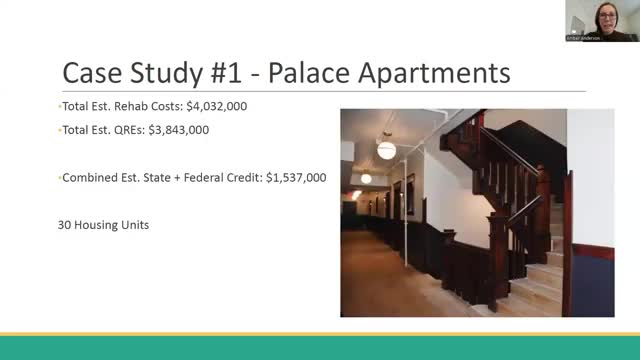Renovation project transforms historic apartments amid challenges
August 02, 2024 | Utah Libraries and History, State Agencies, Organizations, Utah Executive Branch, Utah

This article was created by AI summarizing key points discussed. AI makes mistakes, so for full details and context, please refer to the video of the full meeting. Please report any errors so we can fix them. Report an error »

In a recent government meeting, officials discussed the outcomes of three significant rehabilitation projects aimed at preserving historical housing while enhancing living conditions. The projects, which received state and federal tax credits, showcased varying degrees of restoration and investment.
The first project highlighted involved a substantial investment of approximately $4 million in rehabilitation costs, with estimated qualified expenses around $3.8 million. This initiative successfully preserved 28 existing housing units and created two additional units, resulting in a combined tax credit of about $1.5 million. The return on investment was deemed commendable.
The second case study focused on the Wall Parkway Apartments, originally built in 1929. The building had fallen into disrepair, characterized by broken windows and graffiti. Despite the challenges, the rehabilitation maintained key historic features, such as decorative beams and original doorways, while modernizing the interiors. The project incurred about $1.8 million in expenses, with $700,000 in tax credits, successfully preserving 16 apartments.
The final project discussed was the Jackson Apartments, which consisted of two historically significant buildings constructed in 1917. The rehabilitation faced unique challenges due to seismic activity, particularly after an earthquake in March 2020. The project involved upgrading HVAC systems and repairing structural elements, including the removal of a non-character defining chimney. The developer reported that the project was completed with minimal dramatic changes, focusing instead on safety and preservation.
Overall, the meeting underscored the importance of balancing historical preservation with modern living needs, demonstrating a commitment to maintaining the integrity of the community's architectural heritage while ensuring safety and functionality for residents.
The first project highlighted involved a substantial investment of approximately $4 million in rehabilitation costs, with estimated qualified expenses around $3.8 million. This initiative successfully preserved 28 existing housing units and created two additional units, resulting in a combined tax credit of about $1.5 million. The return on investment was deemed commendable.
The second case study focused on the Wall Parkway Apartments, originally built in 1929. The building had fallen into disrepair, characterized by broken windows and graffiti. Despite the challenges, the rehabilitation maintained key historic features, such as decorative beams and original doorways, while modernizing the interiors. The project incurred about $1.8 million in expenses, with $700,000 in tax credits, successfully preserving 16 apartments.
The final project discussed was the Jackson Apartments, which consisted of two historically significant buildings constructed in 1917. The rehabilitation faced unique challenges due to seismic activity, particularly after an earthquake in March 2020. The project involved upgrading HVAC systems and repairing structural elements, including the removal of a non-character defining chimney. The developer reported that the project was completed with minimal dramatic changes, focusing instead on safety and preservation.
Overall, the meeting underscored the importance of balancing historical preservation with modern living needs, demonstrating a commitment to maintaining the integrity of the community's architectural heritage while ensuring safety and functionality for residents.
View full meeting
This article is based on a recent meeting—watch the full video and explore the complete transcript for deeper insights into the discussion.
View full meeting

